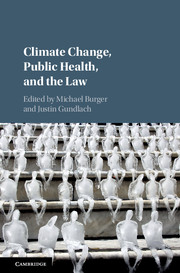13 results
Contents
-
- Book:
- Climate Change, Public Health, and the Law
- Published online:
- 05 October 2018
- Print publication:
- 25 October 2018, pp v-vi
-
- Chapter
- Export citation
Part II - Cross-Cutting Issues
-
- Book:
- Climate Change, Public Health, and the Law
- Published online:
- 05 October 2018
- Print publication:
- 25 October 2018, pp 73-168
-
- Chapter
- Export citation
Index
-
- Book:
- Climate Change, Public Health, and the Law
- Published online:
- 05 October 2018
- Print publication:
- 25 October 2018, pp 435-454
-
- Chapter
- Export citation
Part I - The Context
-
- Book:
- Climate Change, Public Health, and the Law
- Published online:
- 05 October 2018
- Print publication:
- 25 October 2018, pp 1-72
-
- Chapter
- Export citation
Part III - Impacts and Interventions
-
- Book:
- Climate Change, Public Health, and the Law
- Published online:
- 05 October 2018
- Print publication:
- 25 October 2018, pp 169-340
-
- Chapter
- Export citation
Part IV - Interplay with International & Domestic Environmental Law
-
- Book:
- Climate Change, Public Health, and the Law
- Published online:
- 05 October 2018
- Print publication:
- 25 October 2018, pp 341-434
-
- Chapter
- Export citation
6 - The Built Environment
- from Part II - Cross-Cutting Issues
-
-
- Book:
- Climate Change, Public Health, and the Law
- Published online:
- 05 October 2018
- Print publication:
- 25 October 2018, pp 122-168
-
- Chapter
- Export citation
About the Contributors
-
- Book:
- Climate Change, Public Health, and the Law
- Published online:
- 05 October 2018
- Print publication:
- 25 October 2018, pp vii-viii
-
- Chapter
- Export citation
Copyright page
-
- Book:
- Climate Change, Public Health, and the Law
- Published online:
- 05 October 2018
- Print publication:
- 25 October 2018, pp iv-iv
-
- Chapter
- Export citation
13 - How Existing Environmental Laws Respond to Climate Change and Its Mitigation
- from Part IV - Interplay with International & Domestic Environmental Law
-
-
- Book:
- Climate Change, Public Health, and the Law
- Published online:
- 05 October 2018
- Print publication:
- 25 October 2018, pp 373-402
-
- Chapter
- Export citation
1 - Introduction
- from Part I - The Context
-
-
- Book:
- Climate Change, Public Health, and the Law
- Published online:
- 05 October 2018
- Print publication:
- 25 October 2018, pp 3-15
-
- Chapter
- Export citation

Climate Change, Public Health, and the Law
-
- Published online:
- 05 October 2018
- Print publication:
- 25 October 2018
6 - Research Governance
-
-
- Book:
- Climate Engineering and the Law
- Published online:
- 29 March 2018
- Print publication:
- 12 April 2018, pp 269-323
-
- Chapter
- Export citation

